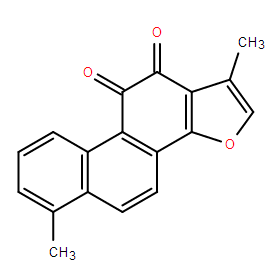| Description: |
Tanshinone I is an inhibitor of type IIA human recombinant sPLA2 (IC50=11 μM) and rabbit recombinant cPLA2 (IC50=82 μM). |
| Target: |
IC50: 11 μM (sPLA2), 82 μM (cPLA2)[1]. |
| In Vivo: |
Tanshinone I shows antiinflammatory activity in rat carrageenan-induced paw oedema and adjuvant-induced arthritis. In order to establish the anti-inflammatory activity of Tanshinone I, the classical animal models of acute and chronic inflammation [rat carrageenan (CGN)-induced paw oedema and rat adjuvant-induced arthritis (AIA)] are employed. When Tanshinone I is orally administered, it shows significant anti-inflammatory activity against CGN-induced paw oedema (47% inhibition at 160 mg/kg), while the IC50 of indomethacin is 7.1 mg/kg. In AIA, Tanshinone I gives 27% inhibition of secondary inflammation at 18 day with an oral dose of 50 mg/kg/day, whereas prednisolone (5 mg/kg/day) shows potent inhibition (65%)[1]. |
| In Vitro: |
Tanshinone I inhibits PGE2 formation from LPS-induced RAW macrophages (IC50=38 μM). When Tanshinone I is added simultaneously with LPS, this compound clearly inhibits PGE2 production (IC50=38 μM) at 10-100 μM. Tanshinone I also reduces PGE2 production (IC50=46 μM) when added after COX-2 is fully induced. The fact that Tanshinone I inhibits PGE2 production by pre-induced COX-2 strongly suggests that this compound may directly inhibit COX-2 activity and/or affect PLA2 activity. When Tanshinone I is incubated with two different forms of phospholipase A2 (PLA2), it clearly inhibits sPLA2 (IC50=11 μM) in a concentration-dependent manner. Although being less potent, Tanshinone I also inhibits cPLA2 (IC50=82 μM)[1]. |
| Kinase Assay: |
As sources of PLA2, human recombinant sPLA2 (type IIA) is purified from CHO cells transfected with the PLA2 gene and rabbit recombinant platelet cPLA2 is obtained through its expression in baculovirus. The standard reaction mixture (200 μL) contained 100 mM Tris-HCl buffer (pH 9.0) with 6 mM CaCl2 and 20 nmol 1-acyl-[1-14C]-arachidonyl-sn-glycerophosphoethanolamine (2000 cpm/nmol) in the presence or absence of Tanshinone I. The reaction is started by adding 50 ng purified sPLA2 or cPLA2. After 20 min at 37°C, the free fatty acid generated is analysed. Under these standard conditions, the reaction mixture in the absence of Tanshinone I released approximately 10% of free fatty acid from the phospholipid substrate added[1]. |
| Cell Assay: |
RAW 264.7 cells are cultured with DMEM supplemented with 10% FBS and 1% antibiotics under 5% CO2 at 37°C. Briefly, cells are plated in 96-well plates (2×105 cells/well). LPS (1 ug/mL) and Tanshinone I are simultaneously added and incubated for 24 h, unless otherwise specified. The PGE2 concentration in the medium is measured using an EIA kit for PGE2. In order to determine the effects of Tanshinone I on PGE2 production after induction of COX-2, cells are incubated with LPS (1 ug/mL) for 24 h and thoroughly washed. Then, Tanshinone I is added without LPS and the cells are incubated for another 24 h. From the medium, PGE2 concentrations are measured. The cytotoxicity of Tanshinone I to RAW cells is checked using the MTT assay. Tanshinone I does not show any cytotoxicity up to 100 uM[1]. |
| Animal Administration: |
Mice[1] In order to evaluate the inhibitory activity of Tanshinone I against animal models of acute and chronic inflammation, rat carrageenan (CGN)-induced paw oedema and adjuvant-induced arthritis (AIA) models are employed. Briefly, 1% CGN dissolved in pyrogen-free saline (0.05 mL) is injected into right hind paw of rats for the paw oedema test. After 5 h, swelling of the treated paw is measured using a plethysmometer. Tanshinone I dissolved in 0.5% CMC is administered orally 1 h prior to CGN injection. For the AIA test, an arthritic inflammation is provoked by injection of Mycobacterium Butyricum (0.6 mL/rat) dissolved in mineral oil to the right hind paw of rats. Tanshinone I is orally administered every day. The swelling of the treated and untreated paws is measured using a plethysmometer. |
| References: |
[1]. Kim SY, et al. Effects of Tanshinone I isolated from Salvia miltiorrhiza bunge on arachidonic acid metabolism and in vivo inflammatory responses. Phytother Res. 2002 Nov;16(7):616-20. |






















